As new parents, many consider using a pacifier when their baby cries, has trouble sleeping, or frequently seeks comfort. The key question is: when is the right time to introduce a silicone pacifier? This article provides a professional guide for parents.
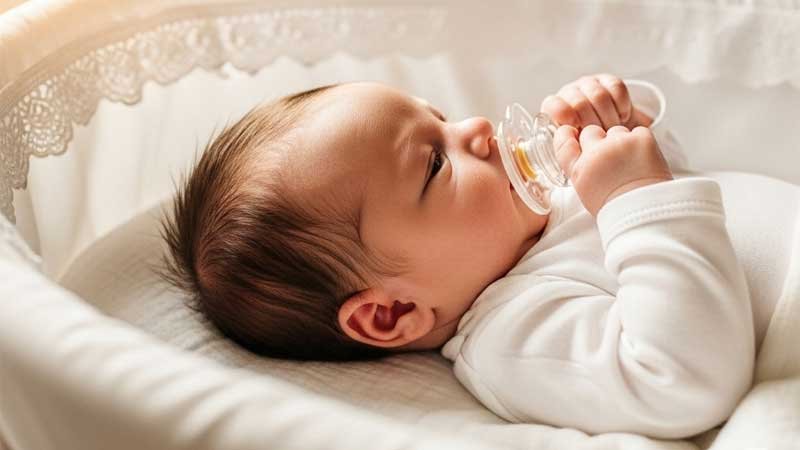
Why Should You Pay Attention to the Timing of Introduction?
Using a pacifier for your baby involves several important considerations: the baby’s oral development and sucking reflex, the progress of breastfeeding, the baby’s ability to self-soothe, and the parents’ care and safety practices.
Introducing a pacifier too early may interfere with the baby’s learning of proper sucking patterns and disrupt breastfeeding. On the other hand, introducing it too late may lead to resistance, as the baby might already rely on other soothing methods. Choosing the right time ensures the pacifier provides comfort and soothing benefits while minimizing potential risks.
When Is It Appropriate for Babies to Use a Pacifier at Different Stages?
Babies grow quickly, and their readiness and need for a pacifier change at each stage. Choosing the right time helps soothe the baby comfortably while avoiding negative effects on feeding and oral development. Here is a detailed guide by age:
| Baby’s Age | Recommendation | Notes |
| Newborn (0–4 weeks) | Not recommended immediately | Focus on establishing breastfeeding and avoid nipple confusion |
| 4–6 weeks | Can consider introducing | If breastfeeding is going well, a silicone pacifier may be tried |
| Under 6 months | Safe to use | Helps with sleep and self-soothing |
| 6–12 months | Can use, limit duration | Watch for teething and avoid over-dependence |
| Over 12 months | Gradually reduce usage | Long-term use may affect teeth alignment and speech |
| 2–3 years | Recommended to stop completely | Continued use may pose oral development risks |
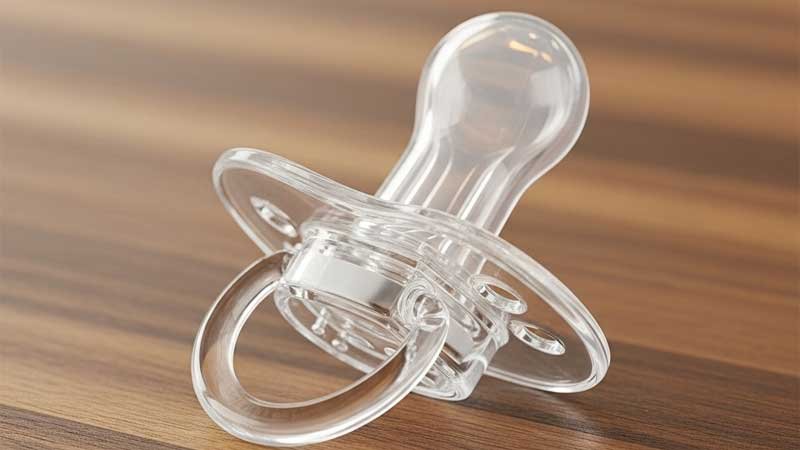
Why Choose a Silicone Pacifier?
Silicone is increasingly popular in baby products, and for good reason. Compared with latex or rubber, silicone offers clear advantages in safety, durability, and ease of care, making it a top choice for many parents.
Safer Material
Silicone is non-toxic, odorless, and BPA-free. It is safe for a baby’s mouth and body, suitable for long-term contact. Compared with natural latex, silicone has a lower risk of causing allergies, making it ideal for sensitive babies.
High-Temperature Resistance
Silicone withstands repeated boiling or steam sterilization without deforming or releasing harmful substances. This prevents bacteria growth and ensures reliable safety for daily use.
Durability
Latex can become sticky, discolored, or even crack over time. Silicone is more stable, lasting longer while maintaining elasticity and shape, even with frequent biting or cleaning.
Transparency for Easy Inspection
Silicone is usually semi-transparent, allowing parents to easily check for dirt, damage, or wear. This makes timely replacement simple and helps ensure the baby’s safety.
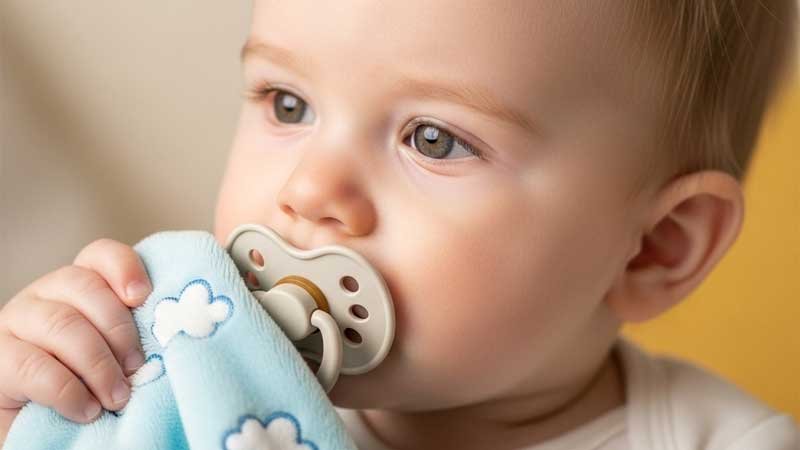
How to Properly Introduce a Silicone Pacifier?
Used correctly, a silicone pacifier can be an important tool for comforting and soothing a baby without causing problems. Parents should pay attention to several key practices during introduction and daily use.
Timing Is Key
The best time to introduce a pacifier is after breastfeeding is well established, usually around 3–4 weeks. By then, the baby is familiar with the breastfeeding rhythm and less likely to experience nipple confusion. Avoid offering a pacifier when the baby is very hungry or upset, as this may increase refusal or fussiness. Choosing a calm and content moment helps the baby accept the pacifier more easily.
Choose the Right Pacifier Design
The design of the pacifier directly affects safety and effectiveness. One-piece designs prevent small parts from detaching, reducing choking risk. Select the appropriate size for the baby’s age (0–3 months, 3–6 months, 6 months+) to ensure comfort and safety. For teething babies, orthodontic pacifiers can reduce pressure on emerging teeth and minimize long-term effects on oral development.
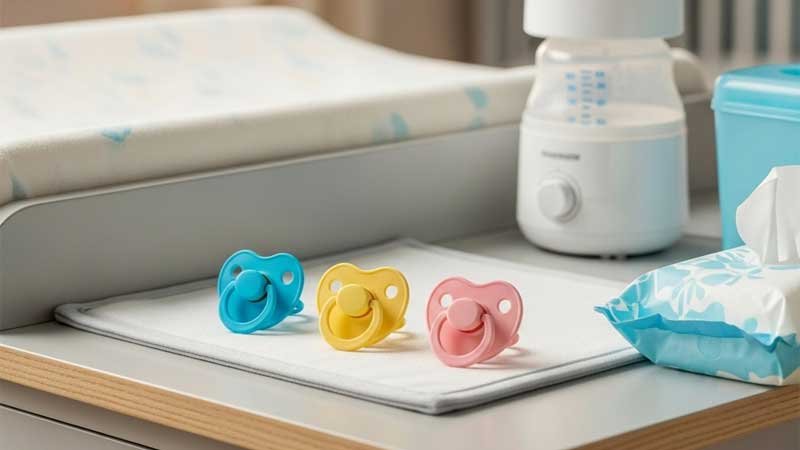
Maintain Cleanliness and Replace Regularly
Although silicone pacifiers are durable, daily cleaning and regular replacement are essential. Sterilize thoroughly before first use and wash every day to prevent buildup of milk residue or saliva. It is generally recommended to replace pacifiers every 4–6 weeks, or immediately if any signs of biting, aging, or cracks appear, to ensure safety and hygiene.
Practical Tips for Parents
Parents should follow these important guidelines:
- Do not apply sugar or honey to the pacifier, as this can cause tooth decay or poisoning.
- Never force the pacifier into a baby’s mouth if they refuse it.
- Remember that a pacifier is a soothing tool, not a substitute for parental care and affection.
- Regularly inspect the pacifier for cracks, wear, or deformation to ensure every use is safe.
When to Wean
The ultimate goal of a pacifier is to help the baby through early soothing needs, not create long-term dependence. Gradually reduce daytime use around 12–18 months, focus on night weaning around 2 years old, and aim to complete weaning by age 3. This approach protects teeth alignment, oral development, and speech, while helping the baby build self-soothing skills.
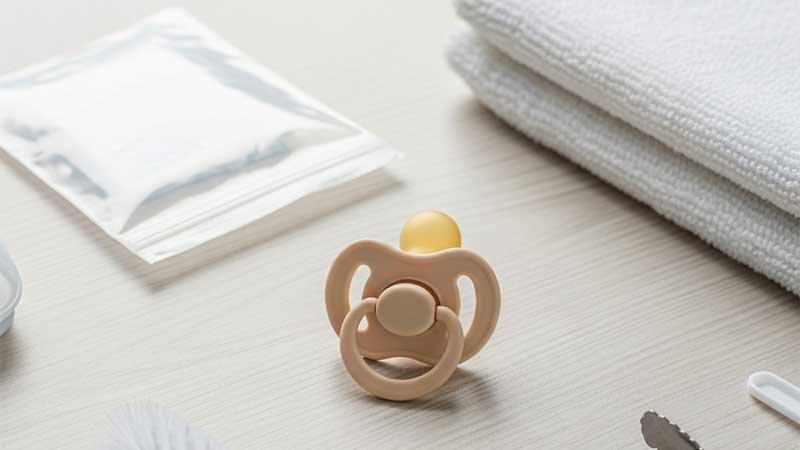
Conclusion
Introducing a silicone pacifier requires patience and careful judgment. It is generally recommended to wait until breastfeeding is well established, around 3–4 weeks, before trying. Silicone is a popular choice for many parents due to its safety, durability, and ease of cleaning. By choosing the right time, maintaining proper hygiene, and helping your baby wean at an appropriate age, a pacifier can provide the greatest benefits.
If you are looking to create high-quality silicone pacifiers or other baby products, we offer customized solutions to meet your exact needs. Contact us today to discuss your designs and bring your silicone product ideas to life.